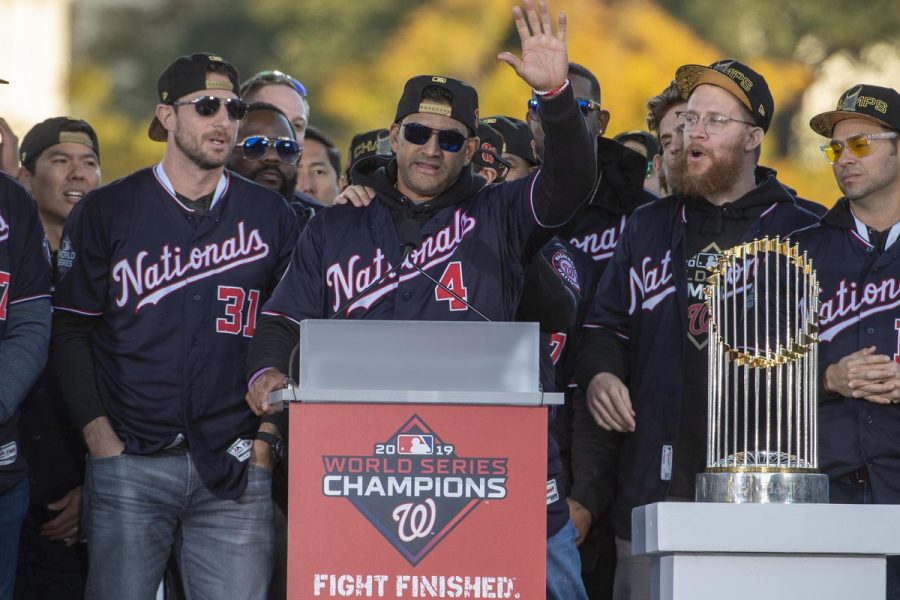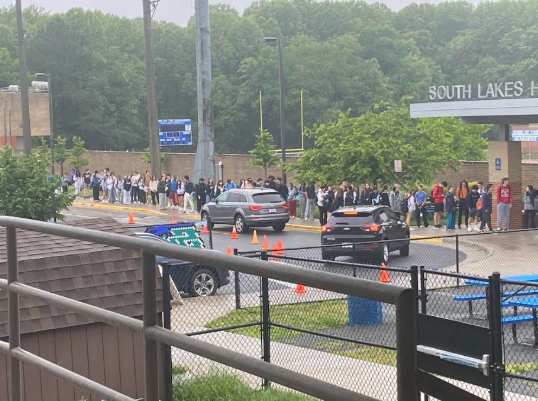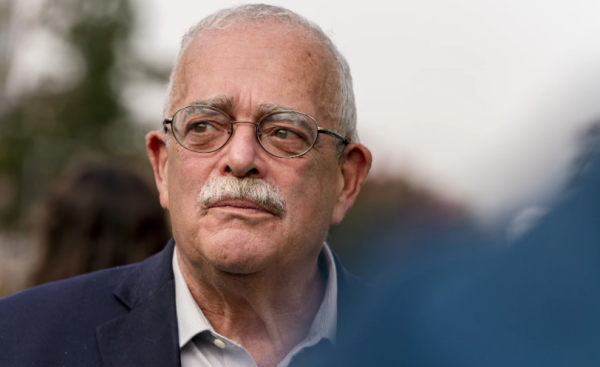Revisiting the 2019 World Series run by the Nationals
For any fan of the Washington Nationals (Nats), the 2019 World Series run will always hold a special place to them. Not only because they won the first title in franchise history and first World Series to be brought back to the nation’s capital since 1924, but because they reversed a long held misconception about the team: The narrative that the Nats could not win the big games, or make it out of the first round of the playoffs. From the depths of despair to the peak of the baseball world—The 2019 World Series Championship run was so indicative of the team’s short history, that it became a near microcosm of the team’s history.
History in the making
To truly understand the meaning behind the World Series run, it is very important to know the history of the Nationals. They started their journey in the District of Columbia in 2005, moving down from Montreal, Quebec. They began their inaugural season in DC with a bang, jumping out to an improbable first place lead at the All-Star Break. The Nats quickly faded, finishing the year with an 81-81 record, a respectable feat, but nothing to truly celebrate. Nonetheless, baseball was back in the District, and no one was complaining about the record the team put up, especially since they were one of the worst rosters in the league.
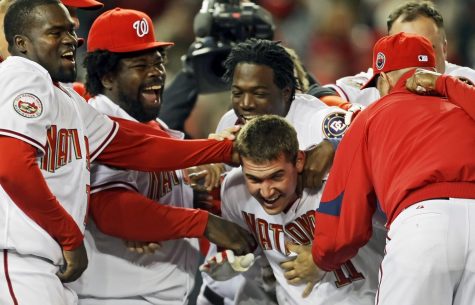
In the coming years, the Nationals ran into very little success, outside of having the young superstar Ryan Zimmerman emerge as the face of the franchise. He was a lone bright spot for the team, which until 2010, had very little to be excited about as far as on-field play. At the start of the 2010 season, the Nationals kicked off the campaign with a nationally televised broadcast of their first game in their new stadium in Southeast DC. That night was capitalized with a Zimmerman walk-off homerun. It was the exclamation point that concluded the beginning of a new chapter in Washington baseball.
Fast forward to 2012, where the team is coming off a surprising 81-81 season, and looking to take over as one of the top teams in their division. They were beginning to see the fruits of their down seasons, with top picks Stephen Strasburg and Bryce Harper, first overall picks in 2009 and 2010. Both were in the big leagues and making an impact. Strasburg was the ace pitcher the Nationals needed, and they made their identity on dominating starting pitching in the future years. Harper was the brash teen that took baseball by storm, giving the team a face that the press could look to for a headline or quote.
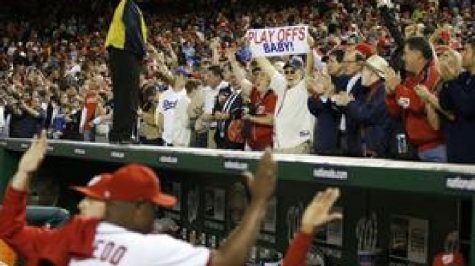
The 2012 season saw the Nats not only clinch their first playoff berth and win their division, but take the best record in the National League (NL). While they lost in the first round of the playoffs on an excruciating loss in the do or die game five, there was a tremendous amount of hope that the 2013 team would be back with a vengeance. That was not the case, as the team fell into a slump that could not be overcome, and they finished the year as one of the biggest disappointments in the league.
By 2014, the Nats were primed for yet another playoff run, and they got the same situation as 2012, with the best record in the NL. Yet once again, they bowed out in the first round. In the 2015 offseason, they made a huge splash, signing Max Scherzer, a perennial super star and ace of any rotation. He prompted analysts and executives alike to ask questions like “Where’s my ring?”, a clear reference to the fact that the team was one of the best in the league. Following the every other year trend, the 2015 Nationals were disappointing in just about all ways, with the lone bright spot being Harper winning National League MVP.
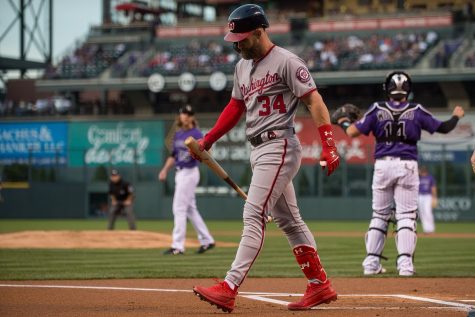
In 2016, the team made the playoffs once again, only to lose in the first round once again. Another berth in 2017, another first round exit, and a new managerial search began as Dusty Baker was not retained, a move that was heavily questioned. In came Dave Martinez, a first time manager tasked with taking a talented team to the playoffs with the looming pressure of Harper’s impending free agency that saw him demand upwards of $350 million, which would be the largest contract in baseball history. In disappointing fashion, the team failed to make the playoffs and the majority of the fan base saw it as the last year with this core of players.
The offseason saw big moves made, just not by the Nationals. Harper spurned the team by signing with the archrival Philadelphia Phillies. The Nationals used the money they would have spent on Harper for Patrick Corbin, a third dominating starting pitcher. Going into the season, the Nats were still seen as pretty heavy favorites to go to the postseason. By late May, the team sat at 19-31, and Martinez was on the verge of being fired.
The Turn Around
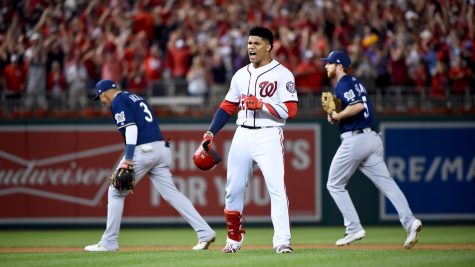
The entire feeling of despair and self-pity turned around as the team got historically hot, and reeled off countless wins down the stretch. They scorched their way into the playoffs, and met the Milwaukee Brewers in the Wild Card Game, a one game matchup that determined who moves on, and who goes home. With everything riding on one game, the team turned to Scherzer to give them a win. Early on, it looked like the wrong move, with the Brewers hitting a home run in the first two innings, and leading 3-0 after 2 innings. A Trea Turner home run made the game 3-1, but it remained that way for a long time, as a combination of Scherzer, and Strasburg, making his first career relief appearance, shut down Milwaukee. The eighth inning was seemingly the last chance for the Nats. Milwaukee’s All-MLB reliever Josh Hader entered, looking for a six out save. He retired the first batter, but a Michael A Taylor hit by pitch, Ryan Zimmerman broken-bat single, and Anthony Rendon walked loaded the bases for younger superstar Juan Soto. Soto was merely 20 years old, unable to drink celebratory champagne in the US until later in the postseason run. He took a 3-1 offering from Hader and lined it into right. From the time he hit it, it seemed likely to tie the game, but when Brewers right fielder Trent Grisham missed the ball, a third run scored, giving the Nats the lead. They would not relinquish the lead, moving on to face the Los Angeles Dodgers.
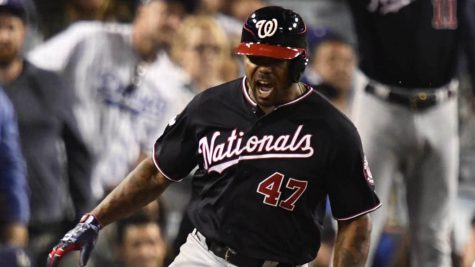
It was in LA that the Nationals would lose the first game of the series. The team rebounded in Game 2, with Strasburg dominating the Dodgers. Tied 1-1 coming back to DC, the Nationals jumped out to an early lead in Game 3, only to watch the Dodgers rout them by a score of 9-3. On the verge of elimination, the Nats turned once again to Scherzer to give them life. The game got off to a tough start, with the Dodgers’ Justin Turner hitting a home run in the first inning. The Dodgers got very little offense after that, with the Nationals capitalizing on opportunities left and right, and escaping DC with a tied series, and a Game 5 in LA. It was in Game 5 once again that the team went down 3-1 in the eighth inning. Back to back home runs by Rendon and Soto tied the game, and heading into the 10th inning, the Nationals decided to break the game wide open. With the bases loaded and no one out, Howie Kendrick, the game veteran, became the hero, sending a grand slam into the dark California night. The score was 7-3, and the Nationals would hold on to advance to the NLCS, a place they had never been in the past.
The Nationals faced off against the St. Louis Cardinals in the NLCS, and went on the road for the first two games of the series. A dominating series all around saw the Nationals sweep the Cardinals, with little doubt the entire way, with the team winning each of the four games by scores of 2-0, 3-1, 8-1 and 7-4 respectively. The Nationals advanced to the World Series for the first time in franchise history. Waiting for them in the Series was another giant in the baseball world: The Houston Astros. The Astros won a title of their own in 2017, and looked primed for another, holding big advantages over the Nats in just about every category imaginable. Games 1 and 2 saw the Nats win in shocking fashion, with scores of 3-2, and 12-3. Returning to DC, there was a lot of hope that the team could finish the series at home in the next three games. That would not be the case, with the Astros flexing their muscles on the Nats in DC, winning all three of the games. Returning to Texas, the Nationals found themselves in a familiar spot, in an elimination game. They went on to do exactly what they did in prior games, winning behind a dominating start from Strasburg that cemented him as one of the best pitchers in postseason history.
The Final Game
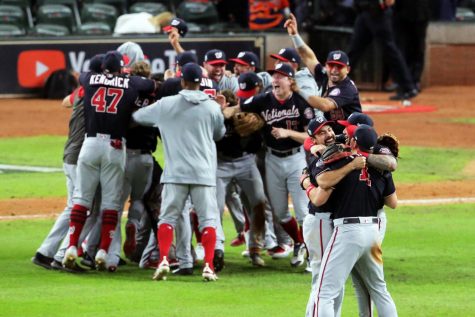
Heading into Game 7, the Nats found themselves pitting Scherzer against Zack Greinke of the Astros, two Hall of Fame bound pitchers going against one another in the biggest game of the season. The biggest game of the season started off terribly for the Nats. Scherzer was unable to keep the Astros at bay in the early innings, giving up two early runs and finioshing five innings down 2-0. Greinke, on the other hand, was dominating, not allowing a hit or run through the first five innings. Scherzer was unable to match him, and in a game like that, it was imperative for the Nats to match the Astros pitch for pitch, run for run. As the game moved into the 6th, the Nats turned to Patrick Corbin to give them a few innings of shutdown pitching. He did just that in the 6th inning, paving way for the Nationals to attempt their comeback. That started with an Anthony Rendon home run that brought the game within one, thus knocking out Greinke, much to the confusion of many. The Astros brought in Will Harris, their middle reliever, who had a good season, but left their ace starting pitcher, Gerrit Cole in the bullpen. As Howie Kendrick stepped into the batter’s box with Soto on first, Harris delivered the offering, a low and outside pitch that Kendrick hit high in the air to right field. The question was not whether it had the distance to get over the fence, but if it would stay fair. That question was answered with a loud CLANG off the foul pole. It was a home run, and the Nationals took the lead! Kendrick, fired up as much as ever during his career, trotted around the bases and began the celebration with his teammates. The Nats were now nine outs away from their first World Series Championship! Corbin went back to work in the 7th, dominating again for another inning. As the Nats kept scoring, the pitching staff kept the Astros at bay. Going into the bottom of the 9th, the Nats had tacked on 3 runs to make the score 6-2. Daniel Hdson quickly got two outs, and in stepped Michael Brantley. With a 3-2 count, Hudson delivered the pitch that changed DC baseball history forever. A swing and a miss by Brantley, and the game was over. Yan Gomes, the catcher for the Nats who held onto the last pitch, launched his mask and sprinted to the mound to begin the celebration. After 95 years, the Nats had brought a title back to the District. They had reversed the course of history for Washington baseball. From a team of sorry losers to disappointments in the playoffs to World Series Champions, the 2019 Nats changed everything in baseball history.
Citywide Celebration
The celebration was on in both Houston and DC, with the watch party in Nationals Park going wild after the last out was recorded. All of that excitement was demonstrated during the parade, where the players were overcome with emotion and excitement. The fans felt the same way, with the raucous crowd letting out years and years of frustration with painful losses and losing seasons. The trophy was held by Zimmerman, Martinez, and Mike Rizzo, the GM of the team. The three men were all architects of the team in different ways. Zimmerman paved the way for this run, by sticking around and staying loyal to the fight even when his body began deteriorating. Martinez made tough decision after tough decision, and Rizzo made all the right moves to assemble this roster. Through thick and thin, the three top men the Nats needed from the start: their franchise icon, their fearless manager, and their relentless general manager all came through when they were needed most.
The biggest theme throughout the run was comradery. When the Nats were at their lowest point, it was cast off Gerrardo Parra who brought energy and excitement to the clubhouse. The dance parties after home runs became a staple in the culture the Nats built that season. The final memory of the team has to be the image of the trophy being held up in front of the US Capitol Building, a photo that will live on in DC sports lore forever.

Marc is a senior at South Lakes and is the Editor in Chief of The Sentinel. This is his 4th year on staff, and third as an editor. Outside of writing for...








